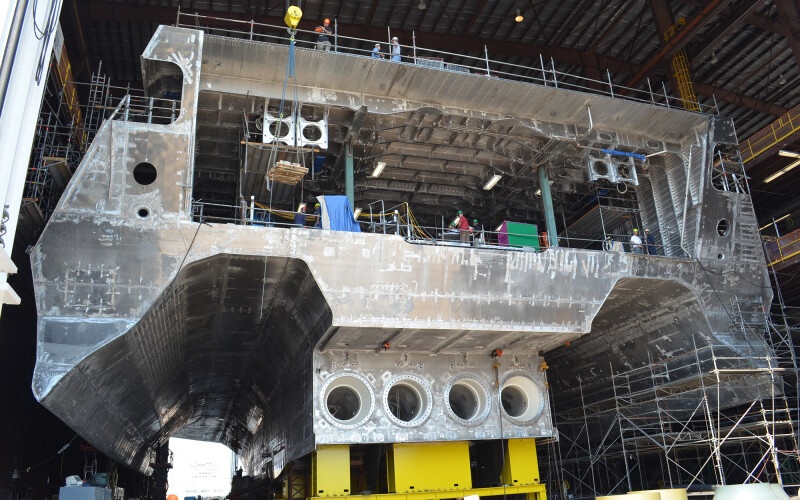After decades of disappointment, America’s conventional shipbuilding industry has been slow to act upon the array of pro-shipbuilding initiatives flowing out of Washington. Despite strong and sustained bipartisan support for the maritime industry from both Congress and the administration, the industry is still wary, betting the federal government’s maritime focus is just a passing fad.
Caution is warranted. In a complex industry, where capital-intensive industrial investments are generally built to last centuries and are paid back over decades, shipbuilders desperately need solid, long-term contracts that don’t evaporate or change over time. But, with maritime technology in flux and the economy uncertain, guaranteed multi-ship contracts are hard to find.
Some new tech-infused shipbuilders, juiced by investor capital and poised to build smaller craft, are rushing in, undeterred by the fact that the U.S. government has a checkered history on the waterfront. Virtually every big U.S. shipbuilder in business today can ruefully point to billions in capacity expansion or shipyard modifications that were done with the promise of future work — work that eventually evaporated.
These missteps don’t often make headlines. They’re slow-moving disasters, stretching out over years.
Governmental tinkering can trip up startups. More than a decade ago, Austal USA — then the brash new shipbuilder of the day — sized its new shipyard to address the government’s stated requirement of 55 littoral combat ships (LCS). Between 1999 and 2009, the young Australia-based company took big risks for the contract, plowing some $227 million in current dollars into the shipyard. But the massive LCS fleet that Austal’s newly-built shipyard was crafted to support quickly vanished. First, the LCS program was evenly split between two shipyards, only to be cut and cut again. Austal ended up with orders for just 19 LCSs, and the organization has, over the past decade, struggled to get over the U.S. government’s initial “bait-and-switch”.
These abrupt shifts in emphasis echo though the industrial base for decades.
In Maine, Bath Iron Works is still struggling to recover from the 2008 truncation of the Zumwalt-class destroyer program. Shortly after buying Bath Iron Works in 1995, General Dynamics began retooling its old-school shipyard to handle the big, new vessel, reorienting everything from the yard’s workforce to the shipyard’s layout so the site could efficiently build an expected fleet of 32 destroyers. After two decades of work, and an investment of at least $675 million in today’s dollars to build a high tech “Ultra Hall” and “Land Level Transfer Facility” sized for the big new destroyers, the Zumwalt program collapsed. Bath ended up only producing three of the newfangled ships. And now, 15 years later, the storied shipyard is still fighting to reconstitute its legacy Arleigh Burke-class destroyer production line.
Other countries do things differently. In some cases, shipyard improvements come with an enormous government-backed orderbook. King Salman International Complex for Maritime Industries and Services, the largest shipyard in the Middle East and North Africa region, was built around longstanding guaranteed contracts. Almost 10 years ago, the largely state-owned companies of Saudi Aramco and Bahri ordered 20 rigs and 52 new vessels from the nascent shipyard, guaranteeing a $10 billion off-take. That deal is still solid, and the shipyard is marching through the government-backed backlog. That’s the type of long-term buy-in the U.S. government has been unwilling to make in the maritime industry.
Even if technological, economic, and geopolitical changes are driving uncertainty into the maritime sector and forcing America to hedge its bets, the U.S. government could do worse than follow the national shipbuilding strategies of Australia, Britain, and Canada. These efforts might break the rigid rules of capitalism a bit, sending Federal Acquisition Regulation aficionados to the fainting couch, but they do commit governments to send steady work to shipbuilders, allowing them to deploy resources in a measured fashion over time.
This national-level approach is good for the entire industrial ecosystem. Upstream suppliers remain assured of a steady demand signal, and new entrants can, if they meet certain benchmarks, get a book of business. And, with a strong foundation, healthy national shipbuilding networks can flex in response to need. This is what the Trump administration’s executive order for the maritime industry seems to be driving toward. But, to get shipbuilders and shipyard suppliers to invest billions into improvements or new shipyards, Washington must put up billions for guaranteed shipyard work as well.




